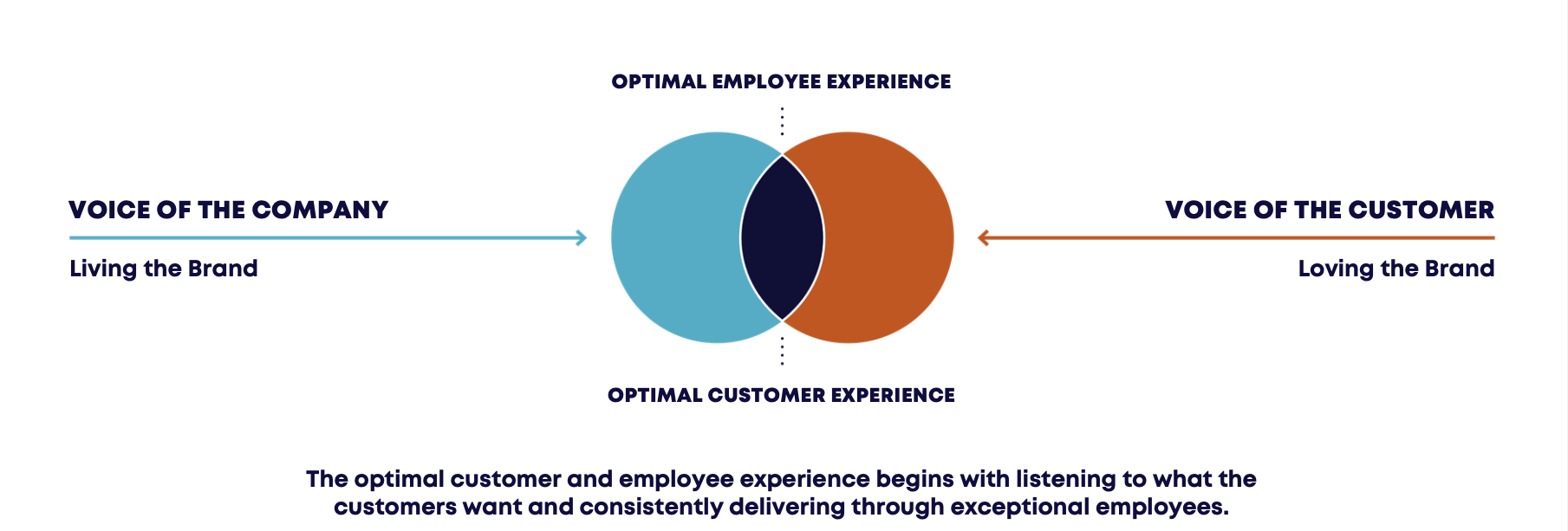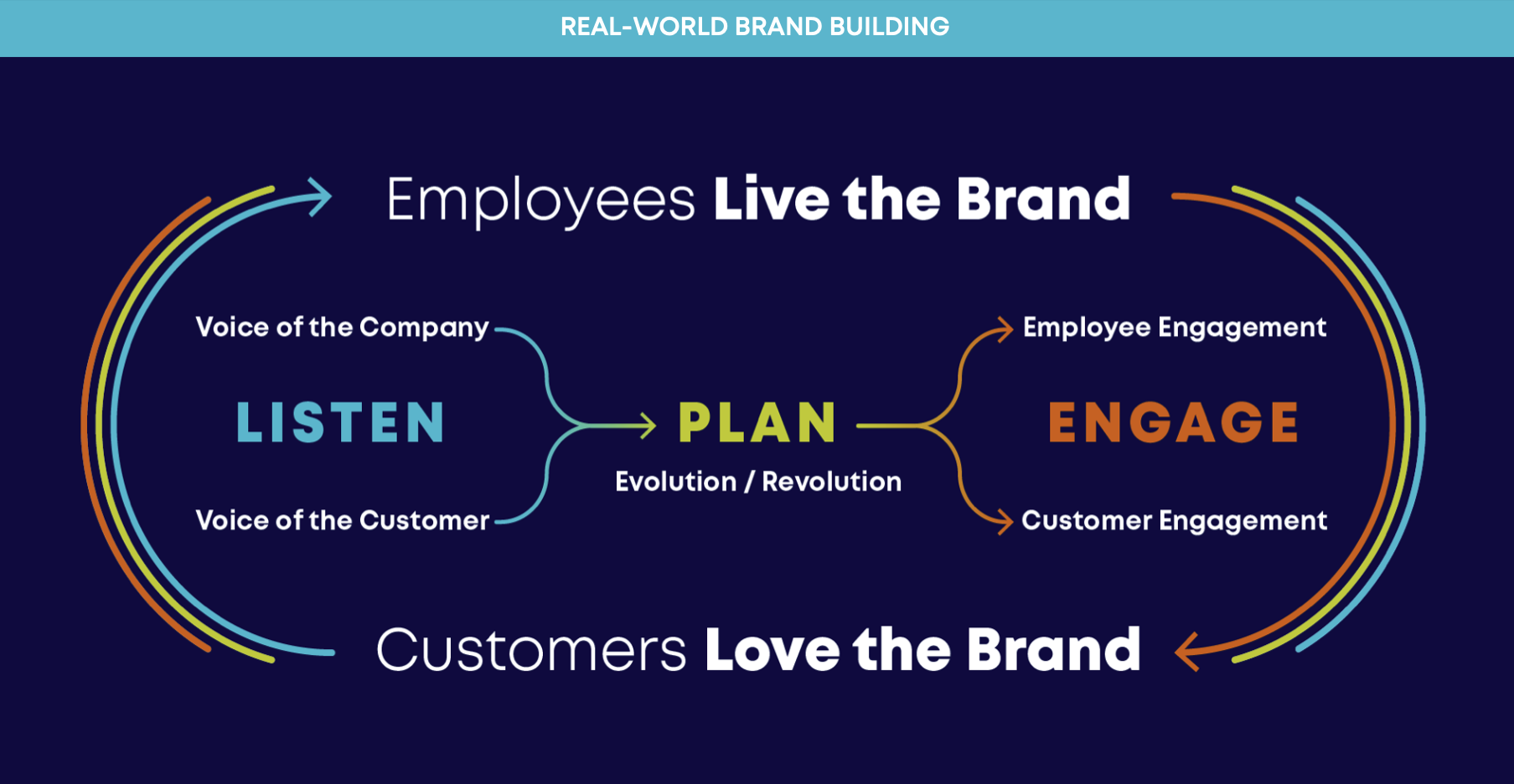Real-World Brand Building – The Listen, Plan, Engage Framework for Exceptional Customer Experience

Experience Economy
We are in an “experience economy” – companies that create lasting relationships with their customers through intentional, positive, and consistent experiences earn competitive differentiation and premium pricing advantages. The “stickiest” experiences are difficult to replicate, more so than products or services, which creates a leg up in the marketplace for businesses that prioritize the customer experience.
A well-executed customer experience strategy will maximize customer lifetime value, increase customer satisfaction, accelerate profitable growth, and decrease churn rate.
A Bain & Company study showed that 80% of companies believe they have a great customer experience (CX) – but of those, only 8% of their customers agreed.
So how do you make CX a fundamental, durable area of focus and excellence?
Let’s start by defining what CX is…
Customer Experience vs. Customer Service
It is no longer enough to lean on Customer Service (the function and set of related processes) alone, as it is only one component of a larger customer experience strategy.
But what’s the difference between Customer Experience and Customer Service?
Customer Experience is the sum-total of all touchpoints a customer has with a company. It is how the customer is made to feel as they interact with your brand and business, whether it is the first interaction or the 30th. Customer Service, on the other hand, is a momentary transaction that occurs when there is a specific problem or need.
.png)
As opposed to Customer Service – which involves a specific team – everyone at the company is responsible for delivering a great customer experience. From the “front of the house” where the action happens – the sales team, store personnel, etc. – to the “back of house” where all the internal processes work, each role contributes to a winning CX.
Engaged employees = Great Customer experience
We always say that the “best brands are built inside out.” That’s because exceptional customer experience starts with an engaged and inspired internal team.
When the voice of the company, those internally who are ‘living’ the brand, intersects with the external voice of the customer, those ‘loving’ the brand, the conditions exist for an optimal employee AND customer experience.

We know that engaged employees deliver great customer experiences and happy clients lead back to ever more engaged employees – it’s a virtuous cycle. As such, it is essential to study and document employee and customer needs and frustrations as a foundation for all that comes after. The fastest path to improving the customer experience is to improve the employee experience.
Putting it in Practice – Introducing “Real-World Brand Building”
That’s why – when reimagining our service architecture – we established the below framework: Listen, Plan, Engage. Instead of lists of services delivered in silos, we’ve chosen to illustrate it as the continuous cycle it is – bridging, because they are interrelated, employee AND customer experience.
At Finch Brands, we position brands and businesses for ongoing success by championing purposeful change – amplifying voices with insightful listening, building action plans for strategic evolution, and stimulating engagement with informed creative execution. Clients may come to us for some, or all, of that – but it’s still helpful to envision it as a process rather than a series of cul-de-sacs.

Listen. To your employees and customers.
Real-world brand building starts with listening. The companies that know their people and their customers best, win!
Inside, outside, and end-to-end, we help our clients listen more deeply, thoughtfully, and regularly to their key brand stakeholders – teammates, customers, and prospects.
Internal Listening
- Engagement surveys
- Brand Purpose surveys
- Focus groups
- In-depth interviews
- Brand tracking
- Insights communities
External Listening
- Qualitative research
- Quantitative research
- Custom project-based insights
- Insights communities (Here’s a guide to What is An Insights Community)
Plan. Build a roadmap for purposeful change.
Data drives strategic planning – and our services encompass the key strategic elements that fuel business growth.
If you don’t know where you’re going, any road will take you there. We ‘plan the work’ to prepare our team and clients to ‘work the plan.’
This could mean:
- Strengthening and clarifying your company’s Purpose, Mission, and Values
- Defining go-to-market messaging
- Building customer profiles
- Making sense of complicated brand architecture
- Creating innovation roadmaps
- Managing complex internal and external brand transitions
Engage. Bring core ideas to life for teammates and customers.
With key strategic elements in place, now is the time to engage teammates and customers and drive towards visibility and consistency in how you execute. At Finch Brands, this often takes the form of pulse-quickening brand design and marketing activation.
With data driving everything and core ideas in place, the creative process is purposeful (as opposed to hit-or-miss). From cornerstone brand artifacts – like verbal and visual identity – all the way downstream (website, advertising, packaging, environmental design, brand standards, etc.), design expresses the company’s passion and helps share it with the world.
As they say on the golf course, Finch Brands ‘plays it as it lies.’ Our clients come to us with a range of needs and we seek to be good stewards of resources by focusing only on what is essential to drive business and brand performance.
The Listen, Plan, Engage framework lays out the areas of strength companies need to compete and win in a perpetually changing world. It contains the rudiments of what it takes to craft and execute an exceptional employee and customer experience.
To learn more about CX, check out our newest episode of the Real-World Branding Podcast- Putting Customers at the Center with Trish Wethman, Chief Customer Officer- Best Egg.






